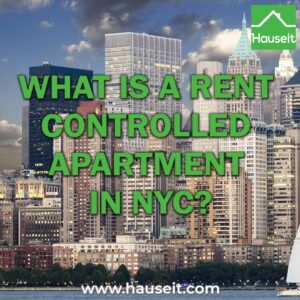A rent controlled apartment is the holy grail of affordable housing in NYC. If you’ve ever heard about someone who pays just a few hundred dollars a month for a prime NYC apartment, chances are that it’s a rent controlled unit.
Rent controlled apartments in NYC are extremely rare, and no additional units have been added to the rent control program for over 50 years. The number of rent controlled units continues to decline as tenants die or move out.
There are just 16,400 of them remaining in NYC according to the 2021 NYC Housing and Vacancy Survey (HVS).
If someone occupies a rent controlled apartment today, the person is either extremely old (having lived there since 1971) or a lawful successor of the original qualifying tenant.
Fortunately, if you’re on the hunt for a NYC apartment rental there are other types of rent regulated units which are still available. These include rent-stabilized apartments as well as units being offered via affordable housing lotteries which are run by the NYC Department of Housing Preservation and Development.
Click on the sections below to learn more. Tired of renting? Estimate your buyer closing costs in NYC using Hauseit’s Buyer Closing Cost Calculator, and consider requesting a Hauseit Buyer Closing Credit to save money on your purchase.
How to find a rent controlled apartment in NYC
There is no way to lease a rent controlled apartment today unless you are a qualifying family member of an existing tenant of a rent controlled unit. When a tenant passes away, the unit leaves the rent control program unless there is a qualifying family member with succession rights.
However, other forms of affordable housing do exist in NYC. This includes existing rent stabilized units as well as apartments offered via a NYC affordable housing lottery.
Rent stabilized units can be found by cross referencing available rental listings with the list of rent-stabilized buildings. You can also use the advanced search feature on rental websites to screen for listings which may have the word “stabilized” or phrase “rent-stabilized” in the listing description.
If you’re lucky enough to find a rent-stabilized apartment, make sure that the lease you sign includes a rent stabilized lease rider, as required by law.
While affordable housing units are initially subject to income restrictions and household size requirements, these units eventually become rent-stabilized apartments.
How is rent control different from rent stabilization?
While rent control and rent stabilization are both forms of ‘rent regulated’ housing in NYC, they have different sets of regulations.
Protections afforded to tenants of rent stabilized units include the following:
-
Limitations on the amount of rent increase
-
Tenants are entitled to receive required services
-
Tenants have the right to renew the lease
-
Landlords have limited ability to evict
The allowable annual rent increase is set by the New York City Rent Guidelines Board (NYCRGB).
A unit generally qualifies for rent stabilization if it’s in a building of six or more units built before 1/1/74 and the tenant took occupancy after 6/30/71.
However, not all apartments in these buildings qualify for rent stabilization. Prior to 2019, rent stabilized units could be deregulated if the next tenant was charged a rent at or above the deregulation threshold.
Here are the historical deregulation thresholds for NYC:
-
$2,000: Tenant moved-in between 1993 and June 23, 2011
-
$2,500: Tenant moved-in between 6/24/11 and 6/14/15
-
$2,700: Tenant moved-in between 6/15/15 and 12/31/17
-
$2,733.75: Tenant moved-in between 1/1/18 and 12/31/18
-
$2,774.76: Tenant moved-in between 1/1/19 and 6/13/19
Rent stabilized apartments are considerably more common than rent controlled apartments. The New York Department of Housing Preservation & Development estimates that there are about 1,048,860 rent stabilized units in NYC compared to just 16,400 rent controlled units.
A Full Service Listing for 1%
Sell your home with a traditional full service listing for just one percent commission.
What apartments qualify for rent control in NYC?
A NYC apartment qualifies for rent control if the building was constructed before February 1, 1947 and the tenant continuously has occupied the unit prior to July 1, 1971. In the case of one- or two-family houses, a tenant must have been living in that apartment continuously since 4/1/53 to qualify for rent control.
The number of rent controlled apartments continues to steadily decline each year as the pool of original tenants continues to age.
An apartment subject to rent control generally becomes decontrolled upon vacancy. Prior to the passage of the The Housing Stability and Tenant Protection Act of 2019, a vacated rent controlled apartment became a fully unregulated, free-market rental if the next tenant was charged a rent at or above the deregulation threshold (which was most recently $2,774.76).
However, a rent controlled unit which is vacated does not necessarily become a free market ‘unregulated’ apartment. The unit typically converts to a rent stabilized unit if the apartment is in a building with six more units constructed prior 1/1/1974.
How do succession rights work for rent controlled apartments in NYC?
A qualifying family member may have the right to a rent stabilized renewal lease or protection from eviction in an apartment under rent control when the tenant dies or permanently leaves the apartment.
According to NYS Office of Rent Administration (ORA), a family member “has the right to a renewal lease or protection from eviction if he or she resided with the tenant as a primary resident in the apartment for two (2) years immediately prior to the death of, or permanent departure from the apartment by the tenant.
The family member may also have the right to a renewal lease or protection from eviction if he/she resided with the tenant from the inception of the tenancy or from the commencement of the relationship. If the family member trying to establish succession rights is a senior citizen or disabled person, then the minimum period of occupancy is reduced to one (1) year.”
Several exceptions exist for the residency period. These include active military duty, enrollment as a full-time student, employment requiring temporary relocation and hospitalization.
Additional exceptions include court ordered relocation or ‘other reasonable grounds’ as determined by NYS Homes and Community Renewal (HCR).
The following relationships persons qualify under the definition of a “family member”: spouse, son, daughter, stepson, stepdaughter, father, mother, stepfather, stepmother, brother, sister, grandfather, grandmother, grandson, granddaughter, father-in-law, mother-in-law, son-inlaw or daughter-in-law of the tenant or permanent tenant.
Interestingly, the definition of “family member” also extends to “any other person(s) residing with the tenant or permanent tenant in the housing accommodation as a primary resident, who can prove emotional and financial commitment and interdependence between such person(s) and the tenant.”
In other words, you may qualify as a successor to a rent controlled apartment even if you aren’t actually a family member in the traditional sense.
There are a litany of tests to determine whether emotional and financial commitment and interdependence between the tenant and such other occupants existed, as outlined in this fact sheet. These include the following:
-
Sharing of household expenses and intermingling of finances
-
Longevity of the relationship
-
Engaging in ‘family-type activities’
-
Formalizing legal obligations via beneficiary designations, power of attorney, will etc.
-
Representing themselves as family members to others
-
Performing family functions or “engaging in any other pattern of behavior, agreement, or other action which evidences the intention of creating a long-term, emotionally committed relationship”
How do rents increase in rent controlled apartments?
Each rent controlled apartment in NYC has a Maximum Base Rent (MBR). This is set by the Division of Housing and Community Renewal (DHCR) and is reevaluated every two years to reflect changes in landlord’s operating costs, which include real estate taxes, water and sewer charges, operating and maintenance expenses, return on capital value and vacancy and collection loss allowance.
The landlord of a rent controlled apartment may raise rents the lesser of:
-
a) the average of the five most recent Rent Guidelines Board annual rent increases for one year renewal leases, or
-
b) 7.5% percent each year until they reach the Maximum Base Rent (MBR) established for your specific apartment







